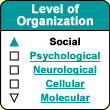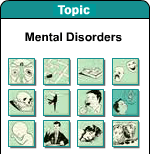|
|

 |
A few simple rules can make it easier to organize the practical aspects of daily life for someone with Alzheimer’s.
First of all, keep the home environment stable. Maintaining the same routine from day to day for things such as meals and bedtime is reassuring for Alzheimer’s people.
Second, simplify the tasks that the person has to perform. For example, to make it easier for them to decide what clothes to put on in the morning, give them only two choices of outfits, and lay them out in advance. But it is also important to let the person continue to perform a few domestic chores, even in simplified form, to stimulate their remaining cognitive abilities.
Loss of orientation in time and space is a characteristic symptom of Alzheimer’s. To help someone with Alzheimer’s stay oriented in time, you can place digital clocks and calendars around their home. To help the person stay oriented in space, make sure not to move any of their familiar markers, such as pieces of furniture.
If need be, you can also use visual prompts—for example, taping a picture of a toilet to the bathroom door.
Wandering is a behaviour commonly associated with Alzheimer’s,
so you must minimize the risks that this behaviour involves. Indoors, eliminate needless clutter, make sure floors are not slippery, store medications and sharp objects safely, and lock the doors to any rooms where the person should not go. Outdoors, make sure the person is always carrying a card or wearing a bracelet that states his or her health condition and gives telephone numbers to call if he or she becomes lost. |
|
|
| FAMILY AND SOCIAL SUPPORT |
|
For people living with Alzheimer’s, support from their family members and social networks plays a critical role in slowing the cognitive losses associated with this condition.
Social support is even considered part of the treatment, because it helps to protect people’s cognitive abilities even in the presence of the brain lesions that characterize this form of dementia.
Moreover, having a rich social life and being involved in one’s community are not only factors in the prevention of Alzheimer’s disease, but also recognized as promoting well-being in all individuals.
Thus every effort must be made to help people with Alzheimer’s have an active social life and prevent them from becoming isolated. But to give them this kind of help, we must be able to communicate with them. Here are some of the strategies and attitudes that can greatly facilitate this communication.
First of all, before attempting to communicate verbally with someone who has Alzheimer’s, you should establish visual contact by approaching them from in front, getting their attention,
and introducing yourself if necessary. The greater the cognitive deficits of the person with whom you are dealing, the more important it will be for you to do these things before trying to talk with him or her.
Next, speak slowly and calmly, establishing a soothing, peaceful atmosphere.
A bit of humour doesn’t hurt either. Use short sentences and simple words and express only one idea at a time. If you are talking about someone else who is not there in the room, don’t use the pronouns “he", “she", “him", or “her"; keep repeating that person’s name instead. When possible, help illustrate what you are saying with visual markers, such as expressive hand gestures.
Encourage conversation by listening attentively. As Alzheimer’s disease
progresses, people often have trouble in expressing their ideas, especially the most abstract ones. Their faces also become less expressive, and their vocabulary shrinks. If you do not understand what the person is telling you, ask only one question at a time, and give them time to answer. Avoid interrupting, criticizing, or arguing with them.
If you have to say no about something, be diplomatic. Don’t just give a flat “no” with no explanation. Instead, say things like, “That’s a good idea, but we don’t have the time", or “I wish I could, but I can’t today", or “Maybe some other time”.
If you are making suggestions, frame them positively, and use diversionary tactics. For example, instead of saying “I don’t feel like staying in the house again", you might suggest, “Let’s go to that pretty little park that we don’t get to very often”.
When the person seems frustrated or keeps repeating the same questions, which may mean they are uneasy about something, pay attention to their non-verbal language. Show care and compassion and don’t hesitate to touch the person’s arms gently, or even to give them a hug. Even people in very late stages of Alzheimer’s retain the ability to recognize signs of affection.
In addition, even though, over time, people with Alzheimer’s lose the ability to form new memories, they can still remember their distant past. You should therefore continue to treat them like adults, and not like children. Also, don’t talk about them as if they weren’t there, because that can be hurtful if they understand you. And be aware of any messages that you may be conveying with your facial expressions and body language, because people with Alzheimer’s can often still sense their meanings.
Paying attention to all these details demands a lot of time and energy from their informal caregivers (the family members and friends who look after them). Hence Alzheimer’s practitioners now recognize that care for caregivers plays just as decisive a role as the attention given to the people with Alzheimer’s themselves.
If you are an informal caregiver for someone who has Alzheimer’s, it is important to look at the results of your interactions with them and correct any mistakes you might be making. In addition to cognitive impairments, people with Alzheimer’s often display problem behaviours, such as agitation, disinhibition, and aggressiveness.
Some of these behaviours may have internal physical causes (for example, they may be the side effects of medications), but others may be due to some problem in the person’s environment (for example, too much noise, cramped conditions, or possessions being put away where they are hard to find). Often, if you pay close attention to the conditions under which these problem behaviours arise, you will be able to find a solution. |
|
|





